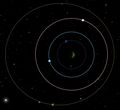Jool/pl
Jooljest Gazowym olbrzymem i szóstą planetą w systemie Kerbol. Jest najbardziej oddaloną planetą i bardzo trudną do osiągnięcia. It is one of the most appealing targets for missions, however, because of its large and complex system of five moons: Laythe, Vall, Tylo, Bop, and Pol. Orbits well-aligned with the orbital plane, and many intersections with moon orbits can easily be captured by a couple moons with little to no ΔV before having to correct your orbit.
Atmosphere
|
Although Jool has a radius ten times greater than Kerbin, its atmosphere begins just twice as high (138.2 km). It is extremely dense, well suited for aerobraking from a high-speed interplanetary intercept. Orbiting just outside the atmosphere will give you a period of 94.7437 minutes, and a speed of 6,785 m/s. You typically do not need to go lower than 60 km to aerobrake. In general, the atmospheric pressure on Jool at an altitude expressed in meters is: Closer to the surface, the physics of the game start to break down. Due to its extremely thick atmosphere, terminal velocity is so low that lighter spacecraft will not even need parachutes or retrorockets. It is not impossible to land on its solid surface, though spacecraft are inevitably and invariably devoured by the Kraken. If a Kerbonaut is put on EVA he will not be destroyed, making one-way sacrificial landings possible. However, as seen near the end of this video, the Kerbonaut will start to glitch out and shake uncontrollably. This only happens if you're on time warp 4. The game will later glitch and cut to a black screen with the altimeter going through numbers rapidly. Unless you restart the game, Kerbin's atmosphere will be missing. |
Natural Satellites
 The ocean moon Laythe, about to transit Jool. Jool has five natural satellites:
Laythe, Vall, and Tylo are in a Laplace resonance, with orbital periods of 1:2:4 respectively. Despite the fact that the moons can easily eclipse both each other and Jool, they do not. Gallery
Trivia
Changes
|
||||||




